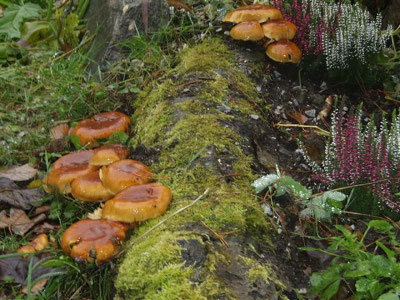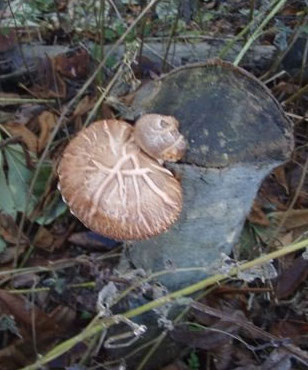
Holzer's easy mushroom cultivation
 Sepp
Holzer's book has a whole chapter on growing edible mushrooms, which
helped me realize that he was probably the one who came up with the
ideas of mushroom
totems and notching
logs for easy inoculation. He also has the
following helpful tips for the permaculture mushroom keeper:
Sepp
Holzer's book has a whole chapter on growing edible mushrooms, which
helped me realize that he was probably the one who came up with the
ideas of mushroom
totems and notching
logs for easy inoculation. He also has the
following helpful tips for the permaculture mushroom keeper:
- Inoculate most logs ASAP, but wait to inoculate stumps until they stop resprouting. (I'll bet this is why neither of my stumps have produced fruit --- the living tree probably killed off the invading fungi.)
- Propagate most mushrooms by spawn, but use spores with woodtufts and enoki. Just place ripe caps on the end of moist, newly cut logs and the fungi will colonize them. However, spore propagation takes much longer than vegetative propagation, even among the mushroom species that handle the process well.
- To plug inocolution holes quickly when you're out in the woods, just stick in a twig of the right size and cut off the excess.
 When inoculating logs with
notches, cut more than half the diameter of the log, fill it with
spawn, and cover the wound with plastic sheeting or adhesive tape.
When inoculating logs with
notches, cut more than half the diameter of the log, fill it with
spawn, and cover the wound with plastic sheeting or adhesive tape.- Rather than sticking mushroom totems in the ground right away, expedite colonization by pushing all of the logs together and covering them with leaves and jute bags. Once fungi have grown through the logs, you can sink them a third of the way in the ground in the direction that the tree grew for low-work fruiting.
- Onion bags full of ripe mushrooms can be hung in trees to spread
spores throughout your woodland.
Although his mushroom
chapter is only twenty pages long, it's one of the best primers I've
seen for homesteaders who want to incorporate mushrooms into their
ecosystem in the easiest ways possible.
| This post is part of our Sepp Holzer's Permaculture lunchtime series.
Read all of the entries: |
Want more in-depth information? Browse through our books.
Or explore more posts by date or by subject.
About us: Anna Hess and Mark Hamilton spent over a decade living self-sufficiently in the mountains of Virginia before moving north to start over from scratch in the foothills of Ohio. They've experimented with permaculture, no-till gardening, trailersteading, home-based microbusinesses and much more, writing about their adventures in both blogs and books.
Want to be notified when new comments are posted on this page? Click on the RSS button after you add a comment to subscribe to the comment feed, or simply check the box beside "email replies to me" while writing your comment.

Having read about Holzer and hugelkultur in "Gias' Garden" I decided to try a couple of hugelkultur piles this winter for a couple of fruit tree starts I recieved last fall.
But after reading all your articles on hugelkultur, and the enthusiasm you have shown I decided to do more then the two piles.
I haave a 15' one that will be for potatoes/onion. I am just starting to pile up limbs along the south side of the hill that will be a good 30' long. Not sure what to put there, but it wont be ready till next spring. I have a couple raised rows I wanted to extend (everyone calls it my grave yard) so I am adding limbs to those rows for a fall planting.
And you were right! The onions transplanted great! They are now taller then the ones that are out in the green house. So, I changed placed with the onions hoping the short ones would catch up.
Thanks.
Anna: Like you, I rake a lot of leaf matter from the forest around me. I also, purchase a dump truck load (5 yards) of mulch, manure, soil mixture from down the road.
So I have the logs layed down. Then limbs and brush on top of that. Then I rake sheets full of leaf debree and lay that over the pile. I use a shovel to poke the leaf debree into the open spaces between the limbs and brush. When I have a nice even pile I fill 5 gallon buckets of mulch and pour it over a good 3 to 4" thick. That is what I will use.
It is very labor intensive. That is why I wont have the long row ready until next spring.
I also run up to Portland (270 mls) a couple times a month to visit with hubby. He is on the heart transplant list. So, a lot of my time is delegated to other things.
But I love my homesteading projects. We've been doing it on and off since 1993.
Just remember that everything you're adding except the manure is high in carbon, so be sure to add lots of manure anywhere you're going to plant right away.
I know what you mean about labor intensive! I'm building my new beds slowly but surely. I figure there's no big hurry --- we'll be here forever.
Good luck to your husband!